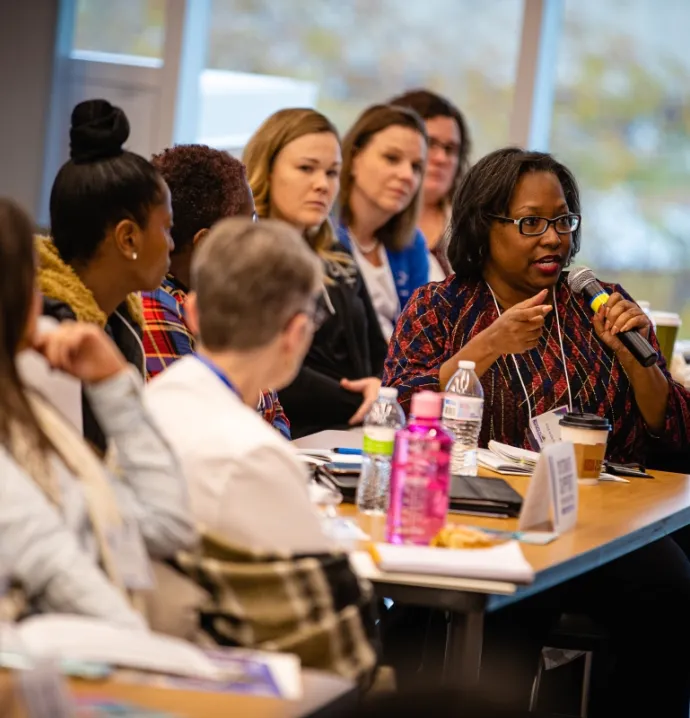UNI students help document a natural phenomenon
UNI students help document a natural phenomenon
When Laura Jackson sat down at her desk for her first day as director of UNI’s Tallgrass Prairie Center, she was expecting her day to be spent settling into her new job — setting up her email, organizing her workspace and getting started on the projects she’d be working on throughout the year. The last thing she expected to do was take a call from a New York Times reporter.
The reporter was working on a story on the declining population of monarch butterflies and wanted to interview Jackson about the Tallgrass Prairie Center’s role in growing milkweeds. The milkweed is the monarch’s only source of food during the caterpillar stage, and is the only plant a monarch butterfly will lay eggs on. Though Jackson was aware of the role of milkweed in the lives of butterflies, she hadn’t yet become aware of just how much the monarch population had been declining.
“That really woke me up,” said Jackson. “I thought, ‘Wow, this is a big issue if the New York Times is chasing us around.’ I started getting educated about it myself and found there’s a national effort to understand their migration and a huge citizen science network.”
She didn’t know it then, but the Tallgrass Prairie Center would end up playing a role in that network, leading to more understanding of the fascinating lives of monarch butterflies — specifically, their annual migration to Mexico — and a unique opportunity for UNI students to get involved.
In 2016, three years after she received that phone call from the New York Times, Jackson launched a special project for her Environment, Technology and Society class, a Liberal Arts Core course that’s open to students from any major. The project focused on documenting the migration of monarch butterflies across campus. This semester, students from the current two sections of this class participated in the project and made some exciting new discoveries in the process.
A natural phenomenon
“A large portion of the monarchs that migrate to Mexico have been produced here in the upper Midwest corn belt historically,” said Jackson. “It really is this amazing natural phenomenon, but we don’t really think about how that creature is depending on flowers here for its migration to fly 2,000 miles. So I thought it would be fun to try to document the migration as it’s going through campus.”
Jackson set up eight stations on different prairie reserves around campus, consisting of poles marking off a 10-meter radius that students would stand in to count how many butterflies crossed through the circle in four separate 15-minute observation sessions. The data gained from these sessions helps give an idea of how many butterflies are making their great migration to the south for the winter.
The project gave many students their first experiences on the campus prairies. This led to a new appreciation for the campus prairies, and nature in general, in addition to the new knowledge they gained about monarchs. Students wrote about these insights in reflective papers they were assigned to write after completing their observations.
"The prairie was really tall and I felt as though, when I stepped into the middle of the prairie, I was stepping into the life of an animal,” wrote music education major Eric Green in his reflection. “When looking at the prairie, I had a first-hand look at how the prairie provided shelter and food in abundance and how it wasn't just a bunch of grass idly sitting around.”
A warning signal
The importance of prairies is just one of the many significant issues the project helped students learn about. The monarch's life cycle, as well as their population decline, is tied to a number of other social, political and environmental issues, all of which are of particular relevance to Jackson’s capstone class.
While monarchs don’t play as large a role as bees (another species whose decline has been a concern recently) in pollinating the food we eat, monarch butterflies are indeed pollinators, as well as an important part of the ecosystem, as a food source for other insects and birds.
But their decline is about much more than the survival of an ecosystem of small creatures. As cold-blooded animals, their migration — and survival — relies on specific weather conditions that are being threatened by a changing climate. More than that, the decline of monarch butterflies is a warning signal of what could happen to other species — including humans — in the face of climate change.
“We’re entering the sixth mass extinction on the planet,” said Jackson. “The others were caused by volcanoes and asteroids. This one is caused by us, and we’re right in the middle of it. To get people to think about it and what that means, they have to have direct experience.”
That’s why Jackson chose to focus on monarchs for her project for this class. As an animal with close ties to Iowa that can be found in anyone’s backyard, it made these large-scale issues hit closer to home.
"To think Iowa was covered with prairie is absolutely crazy to think about, primarily because I now realize the size of the ecosystem to which we have just destroyed and how many different plants and animals we have displaced,” wrote Green. “It seems almost unfair that we got rid of this entire ecosystem and what we have replaced it with. I feel like [when I was standing on the prairie] I was standing on the skeletal remnants of what was once the most intricate ecosystem in the U.S."
Positive changes
Giving students first-hand insight into these large-scale issues is exactly what Jackson hoped this project would do. She wanted students to ask important philosophical questions, as well as connect these larger issues and the natural phenomena discussed in class with their daily lives.
“In class, we talk about this idea of intrinsic value of a species versus valuing it for its utility to people. That’s a philosophical discussion that’s appropriate to have, and I try not to tell people what to believe, but just to have them think about that a little bit,” said Jackson. “So it isn’t just a ‘dancing through the meadow’ exercise. There are practical implications.”
And it’s not all climate gloom and doom. In fact, the findings from this year’s project suggest that a positive change might be on the horizon. Sightings have gone up since the project began — in 2016, class observations averaged just over six butterfly sightings per hour. But sightings increased each year, with the average reaching a high of sixteen per hour this year. On September 15, the migration’s peak on campus, students were seeing an average of twenty-seven per hour.
This seems to reflect a national trend — sightings of monarchs this fall, their peak migration time, have increased nationally as well, in what’s being described as the largest migration in recent history. Migrating butterflies even made national news recently, when they showed up on the National Weather Service Radar.
However, it’s unclear if all of these monarchs will make it to Mexico and if this population increase will be sustained or is just normal fluctuation. Not to mention, the increase still isn’t enough to make up for the 90% decline that’s happened since the 1990s.
“The numbers are going up, which is good, but that doesn’t mean that the problem is solved,” said Jackson. “What we want to see is a five-year average.”
Still, between the increased sightings Jackson’s classes have witnessed since 2016 and the new awareness of the environment that students gain, Jackson can’t help but feel hopeful.
“I’m getting the sense that people are learning, and they’re having a meaningful experience they will remember and be useful to them,” she said. “They may think they’re only doing this for an hour, but I’ve got them looking now — all of September, their eyes are peeled. And wherever they move to when they graduate, there’s going to be some nature, and now maybe some of them have learned how to plug into that.”




